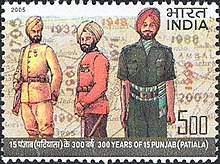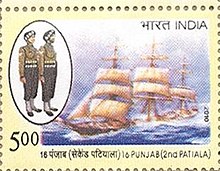| Punjab Regiment | |
|---|---|
 Regimental Insignia of the Punjab Regiment | |
| Active | 1761 – Present |
| Country | |
| Branch | |
| Type | Line Infantry |
| Size | 21 Battalions |
| Regimental Centre | Ramgarh Cantonment, Jharkhand |
| Motto(s) | Khushki wa Tari/Sthal Wa Jal (By Land and Sea) |
| War Cry | Jo Bole So Nihal, Sat Sri Akal (Shout Aloud in Ecstasy, True is the Immortal Lord!) (Sikh) Bol Jawala Ma ki jai (say victory to Mother Jawala) (Hindu) |
| Decorations | • Victoria Cross - 11 • Military Cross - 187 |
| Battle honours | Post Independence Zojila, Icchogil, Dograi, Burki, Kalidhar, Bedori, Nangi Tekri, Brachil Pass, Longewala and Garibpur |
| Commanders | |
| Colonel of the Regiment | Lt Gen Anindya Sengupta |
| Insignia | |
| Regimental Insignia | A Galley with a bank of oars and sail |
| Flag of The Regiment |  |






The Punjab Regiment is the second oldest regiment still in service in the Indian Army, and is the most senior regional infantry regiment. It was formed from the 2nd Punjab Regiment of the British Indian Army in 1947 and has taken part in various battles and wars since, winning numerous honours for the same.
Prior to independence and partition there were a number of "Punjab Regiments" in the British Indian Army. These were amalgamated to form six regiments: the 1st Punjab Regiment, the 2nd Punjab Regiment, the 8th Punjab Regiment, the 14th Punjab Regiment, the 15th Punjab Regiment and the 16th Punjab Regiment. At the onset of independence in 1947, the 1st, 8th, 14th, 15th and 16th Punjab Regiments went over to the newly raised Pakistan Army, while the 2nd Punjab Regiment was retained in the Indian Army. Troops were transferred between regiments based on whether the soldiers would be a part of Pakistan or India.